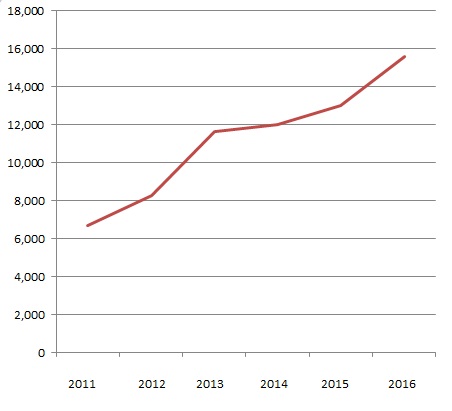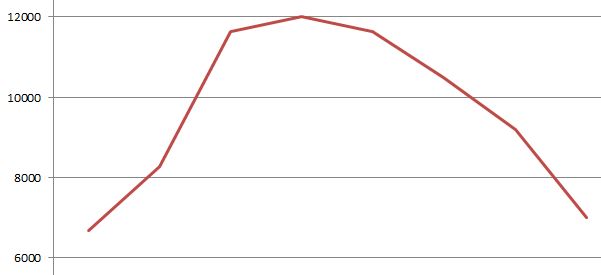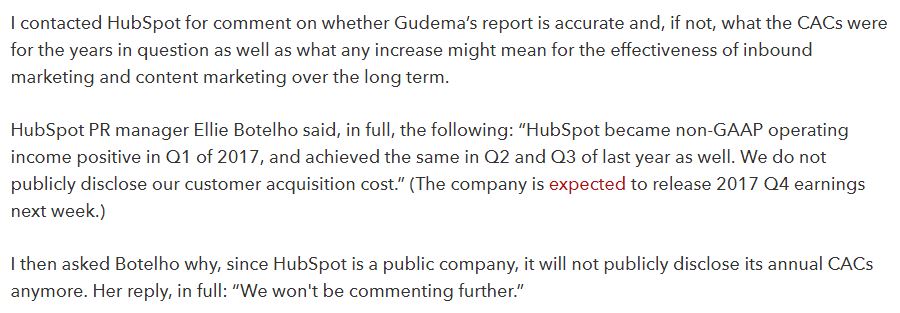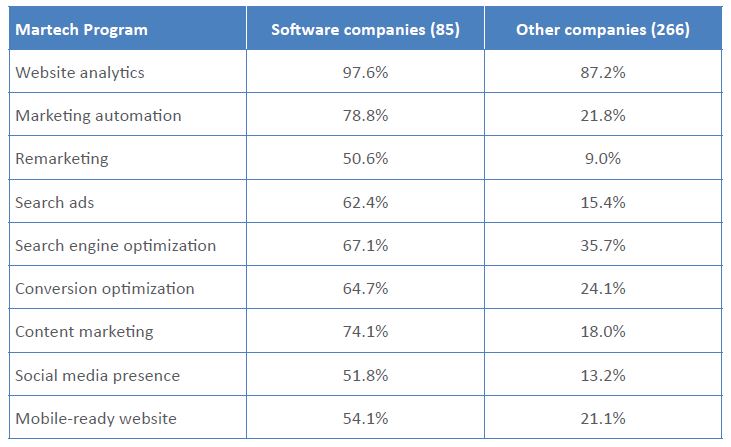In September, 2017, I wrote a lengthy analysis of HubSpot’s customer acquisition costs (CAC), showing that it had more than doubled in just a few years. Since CAC – the average cost of acquiring a new customer – is a key marketing metric, I said that this called into question the whole inbound approach that HubSpot had said they relied so heavily on, and had evangelized almost as much as their marketing software.
The piece got a lot of reads and a fair amount of attention, such as a lengthy analysis from marketing strategist Mark Schaefer. But there was no response from HubSpot.
Until last week.
Last week I saw an article by Ben Jacobson of Marketing Land about HubSpot and inbound marketing in which co-founder and CEO Brian Halligan said, “Inbound marketing at scale works incredibly well. If you look at our cost to acquire customers over time, it’s largely trending down over time…. We’re our own best case study.”
I responded on Twitter and said, no, HubSpot’s CAC was not trending down: just the opposite. And I had shown the data for that over a year ago. This is the chart showing a skyrocketing CAC from my original post:

In the original piece I mentioned that the 2011-2014 figures came from HubSpot’s IPO and first annual report SEC filings. I had calculated the 2015 and 2016 with a formula I developed and explained in a footnote because after 2014 they no longer stated their CAC in their annual reports. The numbers for those two additional years didn’t seem surprising to me since they were in line with the trend of the previous four years.
My tweet last week prompted a swift response from HubSpot’s COO, JD Sherman, that I was wrong:

So he’s saying that, while industry CAC has continued to rise, for HubSpot the chart for the last eight years actually looks something like this:

And they shared the bad news of the first four years in their annual reports, but stopped publicizing it when the news significantly improved.
That’s news because another writer, Samuel Scott from The Drum, had followed up on my article in February, 2018. He couldn’t get that information from HubSpot, either.

CEO Brian Halligan then joined the Twitter conversation last week and did comment further. First he said,

When I responded, he added:

HubSpot is a public company. Their financial information is supposed to be shared with everyone. Why such selective communication of such good news?
Anyway, in a sense it doesn’t matter. The title of my original post was “Can HubSpot afford to do inbound marketing anymore? Can you?” It’s the second question that’s far more important.
Note that each time Halligan says that inbound works “at scale”. HubSpot itself has spent tens of millions of dollars – maybe over $100 million — over the past dozen years producing content for inbound. Only very large companies, or VC-backed ones, can afford to do that (certainly not the SMBs that are HubSpot’s primary market). If that’s the scale that it takes these days for inbound to work in most industries, then my original observations on its dwindling effectiveness still hold.
According to third party SEO tools (SpyFu, SEMrush, Ahrefs, Alexa.com) HubSpot every year gets the equivalent of tens of millions of dollars of paid search traffic to their site for free from their thousands of ranked pages, which have tens of thousands of external links to them. They could literally stop spending any money on new content and, since it’s so hard to displace a highly ranked page, they would continue to get millions of dollars of free traffic for a long time. That can be the long-term value of inbound (if that traffic also generates qualified leads).
HubSpot’s investment, and results, from inbound puts them in what I sometimes call “the marketing 1%”. In fact, they’re in the .1%; their site ranks in the top few hundred sites globally. That’s what investing tens of millions of dollars in content can produce over time.
But this won’t happen for many other companies. The three situations in which inbound may produce results today are:
- Your company is a traditional leader in your industry, possibly through a long-term content program, and has high domain authority
- You’re in a relatively new industry, little content has been produced yet and no one has established a leading content presence (maybe companies in AI were in that position in 2013, they certainly wouldn’t be today).
- You have a very large amount of money to spend on your inbound program, either because you’re large enough or are VC funded.
Secondly, as I mentioned in an article for growth stage VC firm OpenView, HubSpot has virtually re-defined inbound out of existence. The original idea of inbound was totally anti-advertising. In the second edition (2014) of their Inbound Marketing book, Halligan and HubSpot co-founder and CTO Dharmesh Shah wrote about their defining of inbound marketing: “Inbound was about pulling people in by sharing relevant information, creating useful content, and generally being helpful.”
And they continued their disdain for traditional, “outbound” marketing: “Now, raise your hand if you love getting cold calls from eager salespeople during dinner. Or spam e-mails with irrelevant offers in your inbox. How about popup ads when you’re trying to read an article on the Internet?”
But HubSpot now sells ad management software. So on its website it now says things like, “A common misconception is that inbound marketing and display advertising are simply incompatible. Increasingly, however, marketers are combining the best techniques from both to maximize their reach and find qualified potential customers.” I don’t know how that misconception arose.
I won’t go through everything in that OpenView article here, but check it out. In it, I go into much more detail on why the inbound marketing strategy launched in 2006 just doesn’t work for most companies today.
The reality is most B2B companies outside of the software industry are still doing very little marketing. I studied hundreds of them and found this adoption of marketing programs.

Those numbers are from 2014, and when I discovered how little non-software companies were marketing I was somewhere between sobered and depressed. I recently revisited all 351 companies and found that the only significant changes among those non-software companies were (1) 81% of them now have mobile/responsive websites, and (2) 39% are regularly posting to social media. If anything, content programs “at scale” (which for this study I defined as at least six new pieces a month) declined from 18% to 11%.
This was for B2B companies with 50-1000 employees. These were not solopreneurs are very small companies with five or 10 employees. Many of these companies have been around for decades and are the heart of the U.S. economy. The Census Bureau reports that they employ three times as many people as enterprises with over 1,000 employees.
I work with many companies that have previously seriously under-invested in marketing. They aren’t in the marketing 1%, but they probably make up 80-plus percent of the B2B world. My recommendation for these companies is that they defer inbound marketing and use the strategies that I outline in my Bullseye Marketing approach.
Increasingly I am also working with software channel partners, most of which also have been under-investing in marketing. Unlike the software vendors, who are past the Bullseye Marketing stage, these partners could grow much faster and sell through far more software with this strategy.
But if they focus on inbound marketing, they are unlikely to produce few if any results in six months, a year, or even two. And they may well end up saying, “We knew it. Marketing doesn’t work for us.”
That’s what I recommend. But I’ll give Brian Halligan the last word.

